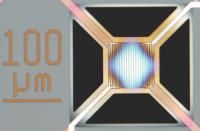Protective Garment: Liquid-crystal rubber suit prevents overheating
Military personnel, chemical workers, and others could benefit from anew synthetic rubber material tailored with liquid crystals. The material might be used to make body suits to protect chemical-industry employees from skin exposure to toxic vapors and aerosols, as well as providing protection for military personnel and civilians in the event of a chemical-weapons attack. The new composite is lightweight and breathable, but still blocks the passage of toxic chemicals, reducing the risk of heat exhaustion in anyone wearing it.
Douglas Gin of the University of Colorado, Brian Elliott at TDA Research Inc., and colleagues, explain that effective personal protection against exposure to toxic vapors is a major concern in industry and in defense. At present, the only certain way to protect people from all chemical vapors to which they might be exposed is to use a hermetically sealed body suit and fully enclosed breathing apparatus. An alternative used by the military is a heavy overgarment lined with activated carbon that can adsorb vapors for a limited time. Such equipment, while safeguarding personnel, is cumbersome, costly, and unwieldy to use in an emergency, as well as coming with health risks if used in hot environments.
To solve this problem, the researchers have turned to a highly effective garment material butyl rubber (BR) used in protective clothing, and have adapted it to a modern application. Butyl rubber,or more formally, linear poly(methylpropene-co-2-methyl-1,3-butadiene)can be chemically modified so that the polymer strands become crosslinked to one another. These crosslinks make synthetic rubber resistant to many corrosive chemicals and give it very low permeability, so that most toxic chemical agents, whether vapor or liquid, cannot penetrate.
The ideal protective garment should be lightweight and selectively block toxic vapors, but be breathable, allowing water vapor to pass outward, thereby maintaining personal comfort and safety. Gin, Elliott, and their colleagues have now developed just such a material based on modified butyl rubber. The material is breathable but also rejects chemical agents. To make their breathable rubber, the researchers originally blended the synthetic rubber with a liquid-crystal molecule that could also be crosslinked like the rubber itself. During preparation of the breathable rubber, the liquid crystals organize themselves into cylinders around water molecules in the reaction mixture. This causes tinywater-filled nanopores just 1.2 nanometers in diameter to form. Only the smallest of molecules can pass through these pores, including water. Many toxicmolecules, nerve agents, and other chemicals are too big to enter the pores. Moreover, the pores are hydrophilic, whereas most chemical warfare agents and many toxic compounds are hydrophobic, so even if they could fit, they would be repelledby the pores.
The researchers tried different liquid crystals in their new composite. The second-generation material does not contain isolated water pores spread across its surface but instead has a manifold network of tiny conduits. The new material is more than ten times as effective at transporting water vapor compared to the original material. It also blocks the passage of CEES much more effectively than pure butyl rubber. The team is now refining the material to make it thinner but just as effective. They are also testing how effective it is at keeping out phosphorus ester-based chemical-warfare agents.
Original publication: Douglas Gin et al.; "Crosslinked Bicontinuous Cubic LyotropicLiquid-Crystal/Butyl-Rubber Composites: Highly Selective, BreathableBarrier Materials for Chemical Agent Protection"; AdvancedMaterials 2006, 18, No. 24.
Most read news
Topics
Organizations

Get the analytics and lab tech industry in your inbox
By submitting this form you agree that LUMITOS AG will send you the newsletter(s) selected above by email. Your data will not be passed on to third parties. Your data will be stored and processed in accordance with our data protection regulations. LUMITOS may contact you by email for the purpose of advertising or market and opinion surveys. You can revoke your consent at any time without giving reasons to LUMITOS AG, Ernst-Augustin-Str. 2, 12489 Berlin, Germany or by e-mail at revoke@lumitos.com with effect for the future. In addition, each email contains a link to unsubscribe from the corresponding newsletter.























































